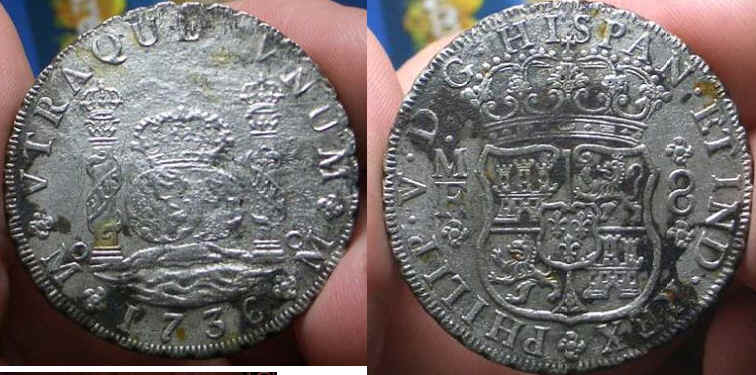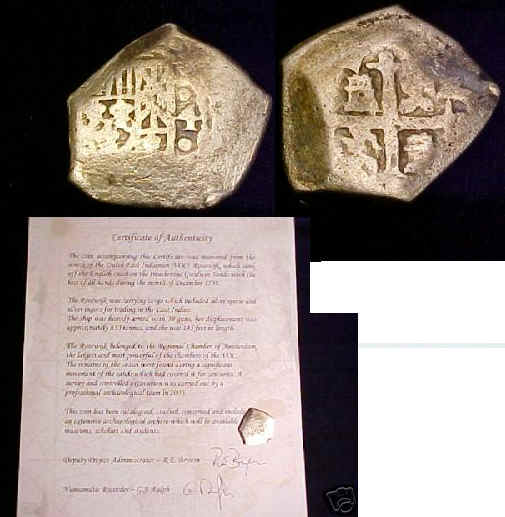
US $89,00 (EUR 67,44), 19-dec-06, ebay, atochabill
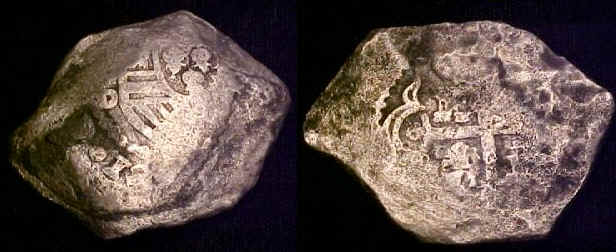
US $89,00 (EUR 68,85), 29-nov-06, ebay, atochabill
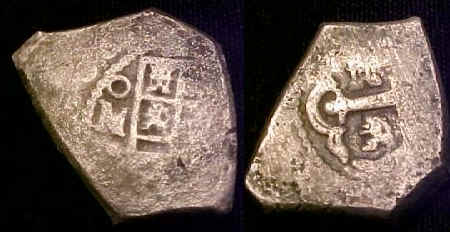
US $91,99 (EUR 71,17), 29-nov-06, ebay, atochabill
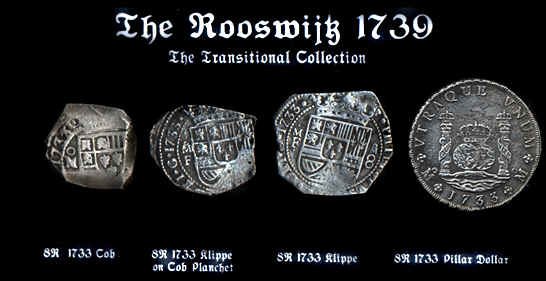
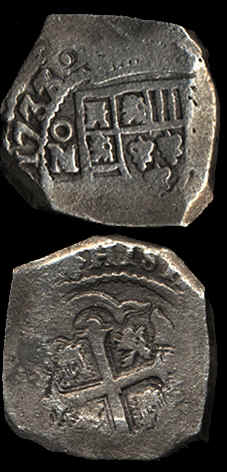 Ship: The Rooswijk 1739 Denomination: 8 Reales/ Type: Cob Details: 27x29 mm / 25.1 grams Reign: Philip V - Date: 1733 Mint: Mexico City / Assayer: "F" Felipe Rivas Angulo / Code: RJ06-0020 |
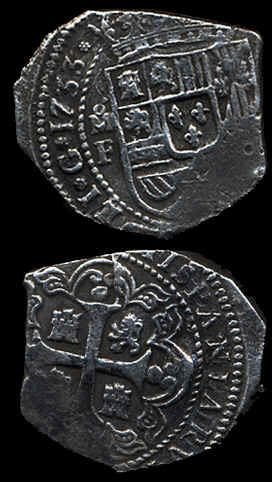 Ship: The Rooswijk 1739 Denomination: 8 Reales/ Type: Klippe struck on a Cob planchet Details: 32x30mm / 25.8 grams Reign: Philip V - Date: 1733 Mint: Mexico City / Assayer: "MF" Manuel de la Pena & Francisco de la Pena Flores / Code: RJ06-21 |
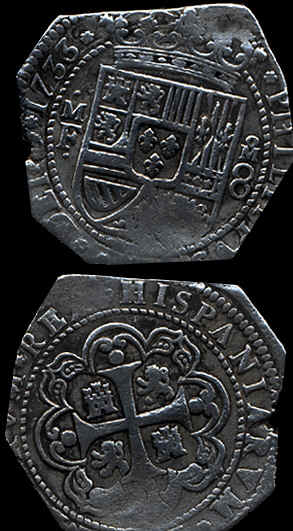 Ship: The Rooswijk 1739 Denomination: 8 Reales/ Type: Klippe Details: 35x34mm / 26.35 grams Reign: Philip V - Date: 1733 Mint: Mexico City / Assayer: "MF" Manuel de la Pena & Francisco de la Pena Flores / Code: RJ06-0022 |
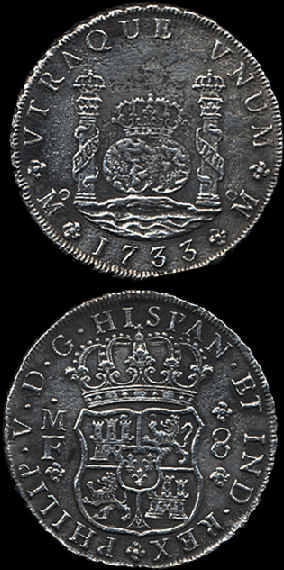 Ship: The Rooswijk 1739 Denomination: 8 Reales/ Type: Pillar Details: 40 mm / 25.5 grams Reign: Philip V - Date: 1733 Mint: Mexico City / Assayer: "MF" Manuel de la Pena & Francisco de la Pena Flores / Code: RJ06-0023 |
The Dutch East India Company, known as the "Floating Republic", was perhaps the World’s most powerful corporation in the 17th century. It had received its articles of incorporation on March 20th, 1602 as the Verenigde Oostindische Compagnie, or VOC in short, literally " the United East Indies Company" It was initially granted a 21-year monopoly to carry out colonial activities in Asia. That 21 year charter was continued and renewed for almost two centuries, until it finally went bankrupt and was dissolved in 1798
During late December 1739 the Rooswijk, one of the retour ships of the Dutch East India Company was ready for its second long journey to the Indies. Accountants and officials of the company supervised the loading of 30 chests of silver coins minted primarily in Mexico. Each pine chest was wrapped in canvas, tied with rope, and sealed in red wax with the personal seal of the captain. The journey was ill fated from the beginning, and the Rooswijk struck the treacherous Goodwin Sands off the South East coast of England in a heavy storm. The weather that winter was so bad that the wreck site was unapproachable and the remains of the Rooswijk lay covered in many feet of sand for another 265 years.
In December 2005, it was made public that between May and September of that year a team led by Rex Cowan had recovered some of the ship and its contents. This was done in secrecy to avoid attracting looters. Lying at a depth of about 24 m, the Rooswijk was discovered by an amateur diver in 2004. The numismatic Treasures recovered from the Rooswijk Shipwreck offer a rare opportunity to better study and understand coinage of this period. What makes this shipwreck and discovery so unique is that the coins that were recovered are from a transitional period in the history of the Mexico City Mint. In the early 1730's, the introduction of new minting equipment lead to the gradual phasing out of older coining methods, numerous different coinage types and varieties came together.
In 1733 the mint produced more different types and varieties of 8 Reales than in any other single year. Four major different types of these were: cobs, cobs struck with "Klippe" dies, Klippes and the Milled "Pillar Dollar". 1733 marked the end of the "Cob" coinage production. One remarkable detail about the Spanish Colonial coinage is that 8 Reales or "pillar dollars", minted in Mexico City, circulated in The United States of America as legal tender until 1857.
Here is a truly unique collection of the treasure coins from the wreck of the VOC merchantman Rooswijk.
This set contains ALL of the FOUR types of coins minted in Mexico City in 1733.
This complete set of 1733 issues includes a 1733 cob, a 1733 Klippe, a 1733 Klippe struck on cob planchet, and a 1733 Pillar Dollar.
This is a one of a kind set, and only one we are likely to have! Only one 1733 cob has been released by the salvors,
In 1536 the Mexico City Mint became the first mint to produce coins in the New World. The mint primarily used a method of hammering coins by hand, known as Cob or Hammered coinage. Cobs were produced by placing a blank piece of metal "planchet or flan" of the correct weight between two dies, and then striking the upper die with a hammer to produce the required image on both sides. This method remained in use until it was totally replaced in 1733 by the screw press that we know as Milled coinage. The change took place by a royal order issued in 1728 that authorized the Mexico City mint to strike new milled coins. In 1733 the mint produced more different varieties of 8 Reales than in any other single year. These were classified into four types: Cobs, Cobs struck with "Klippe" dies, Klippes and the Milled "Pillar Dollars."
The Klippe type coin is also known as a Recortado. The rarest of all four of these types of coins minted in 1733 are the Klippes that were struck on cob planchets. They mark the changeover from hammered “cobs” coins to milled technology and 1733 becomes the final year of “cob” coinage production. Klippe planchets were produced, first by rolling or flattening silver into a sheet by mule powered roller presses. Planchets were then cut from the sheet and weighed. If needed, adjustment cuts or clips were made until the planchet or blank was of the correct weight standard. According to an original 18th century mint manuscript, the new equipment in route from Spain that included 3 new screw presses sank off of the Coast of Little Cayman Island. This lack of equipment, and trained personnel resulted in the production of transitional issues during this period. In 1734 the mint discontinued the production of the Klippes and converted exclusively to the striking of milled Pillar Dollars, making 1733 the rarest Transitional year for the Mexico City mint.
US $8.950,00 EUR 6.924,03, niet verkocht, 28-nov-06, ebay, shipwreckcoins
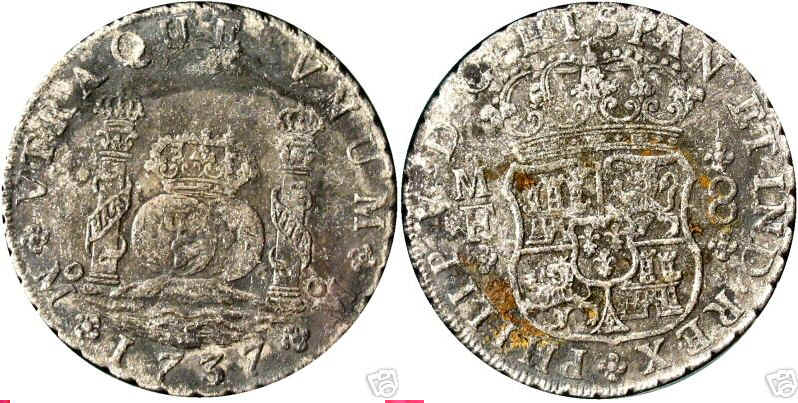
US $73,55 (EUR 54,16), 02-jul-07, ebay, coinman4u
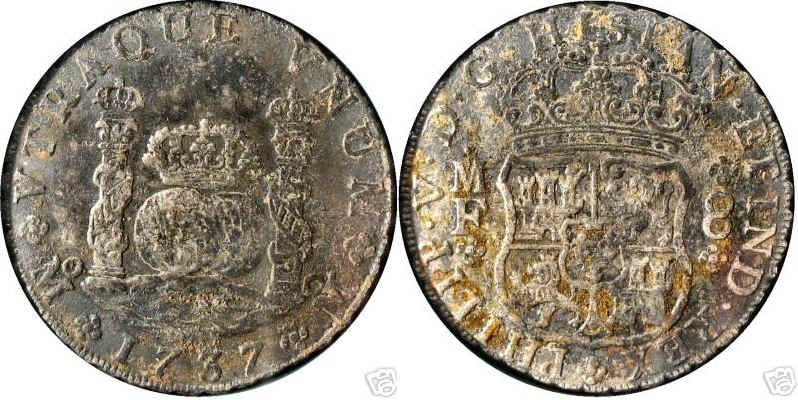
US $84,00 (EUR 61,85), 09-jul-07, ebay, coinman4u
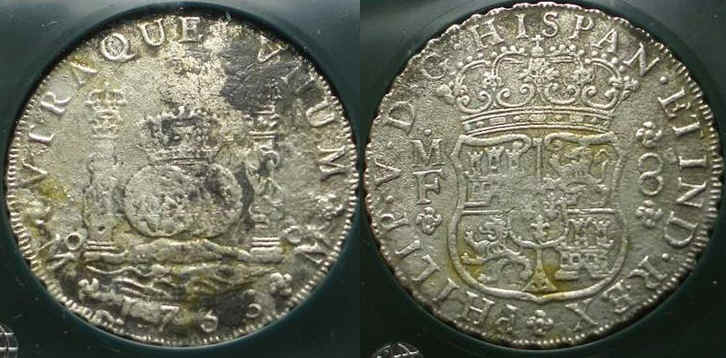
US $122,50 (EUR 90,20), 09-aug-07, ebay, collect-alot-now
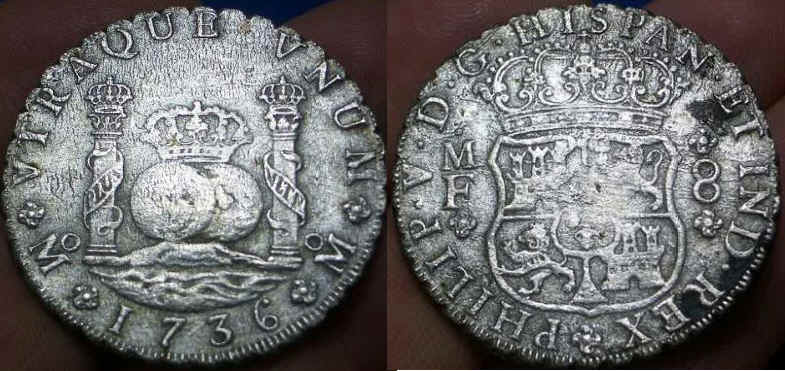
US $265,00 (EUR 166,43), 21-mei-08, ebay, dig_it!
